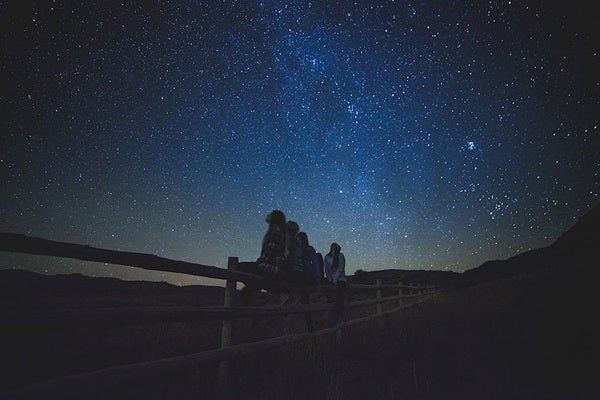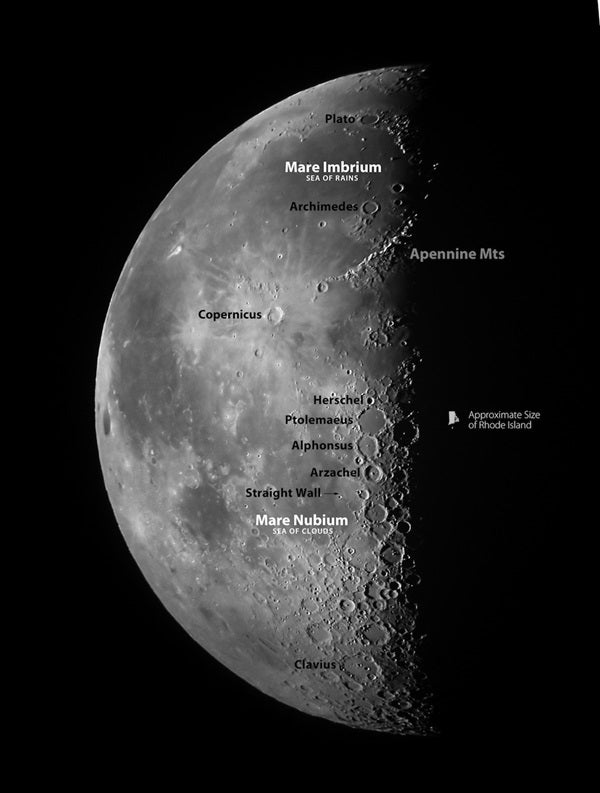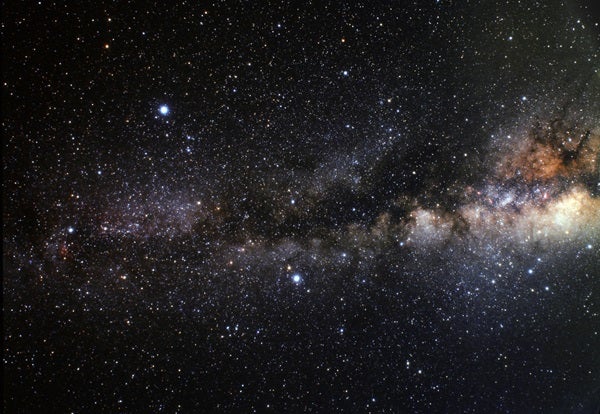One of the spring sky’s finest deep-sky objects, the Beehive star cluster (M44) in the constellation Cancer the Crab, lies high in the south after darkness falls. With naked eyes under a dark sky, you should be able to spot this star group as a faint cloud. But the Beehive explodes into dozens of stars through binoculars or a small telescope.
Saturday, April 7
The waning gibbous Moon joins forces with Mars and Saturn this morning. From mid-northern latitudes, the Moon rises first, at around 1:40 a.m. local daylight time. Saturn follows about 15 minutes behind Luna and Mars 15 minutes after the ringed planet. All three lie against the backdrop of northern Sagittarius, though the Moon’s bright light drowns out most of the constellation’s deep-sky wonders. Notice how the gap between the two planets has grown in the five days since their conjunction. This morning, Mars lies 3° east of Saturn.
Sunday, April 8
Last Quarter Moon occurs at 3:18 a.m. EDT. You can find the half-lit orb rising in the east with the background stars of northeastern Sagittarius around 2:30 a.m. local daylight time; it hangs relatively low in the southeast as twilight begins. The Moon also reaches apogee today, at 1:31 a.m. EDT, when its orbit carries it farthest from Earth for the month. It then lies 251,123 miles (404,144 kilometers) from us.
The variable star Algol in the constellation Perseus reaches minimum brightness a couple minutes before midnight — 12:00 A.M. EDT — right around the time it’s rising in the northeast. It then shines at magnitude 3.4 where it will remain for a couple of hours before starting to brighten again. If you spot it the following night, you will see it at its maximum — magnitude 2.1.
Tuesday, April 10
Tonight’s sky features a great constellation to look for if you’re just starting out: the small but easy-to-see Corvus the Crow, which lies south of Virgo the Maiden. In size, Corvus ranks only 70th out of the 88 constellations that cover the sky. Now is the best time to spot this pattern. Don’t look for it in September or October, though. That’s when its stars line up with the Sun. You can use Corvus’ top two stars as pointers to a bright blue luminary. Draw a line from magnitude 2.6 Gienah (Gamma Corvi) through magnitude 2.9 Algorab (Delta Corvi). If you extend that line four times the distance between the two stars, you’ll arrive at blue Spica, the brightest star in Virgo.
Wednesday, April 11
Although the calendar says April, the sky’s Summer Triangle returns to prominence in this month’s morning sky. The asterism’s three bright stars — Vega in Lyra, Deneb in Cygnus, and Altair in Aquila — all clear the horizon just before midnight local daylight time. An hour or so later, they rule the eastern sky. Vega shines brightest and appears at the apex of the triangular asterism. Look for Deneb to Vega’s lower left and Altair to the lower right of the other two. The Summer Triangle will grace the Northern Hemisphere’s sky from now through the end of the year.
As you stare into tonight’s starry sky, think about the two space-related anniversaries we celebrate on this date. In 1961, Soviet cosmonaut Yuri Gagarin became the first human to journey into outer space, and the first to orbit Earth. Then, in 1981, NASA launched its first space shuttle, Columbia, on a three-day mission during which it orbited Earth 36 times.
Friday, April 13
This could be your lucky night if you want to hunt down a galaxy. First, you’ll need to head to a dark observing site. Then, with binoculars in hand, scan about one field of view east-southeast of 2nd-magnitude Phecda (Gamma [γ] Ursae Majoris), the star that forms the southeastern corner of the Big Dipper’s bowl. You should see a triangle of 5th- and 6th-magnitude stars. The spiral galaxy M106 lies 1.7° south of 3 Canum Venaticorum, the triangle’s southern tip. The galaxy will appear as an oval blur of light glowing at magnitude 8.4.
Saturday, April 14
Brilliant Venus dominates the evening sky starting about half an hour after sunset. It stands 15° above the western horizon 30 minutes after the Sun goes down and doesn’t set until around 9:30 p.m. local daylight time — a full two hours after the Sun. Shining at magnitude –3.9, it lies in front of the stars of Aries the Ram and appears far brighter than any other point of light in the sky. When viewed through a telescope tonight, Venus spans only 11″ and shows a 92-percent-lit phase.
Sunday, April 15
Dwarf planet 1 Ceres is the largest object in the asteroid belt, which lies between Mars and Jupiter. Almost any telescope will reveal its 8th-magnitude glow. All this month it moves eastward in front of the stars of the constellation Cancer the Crab. You’ll find it tonight between magnitude 4.0 Iota Cancri and 57 Cancri, which glows at magnitude 5.4. It lies two-thirds of the way from the brighter to the fainter star. If you can’t pinpoint it exactly, sketch the area and come back one or two nights later. The point of light that’s moved will be Ceres.












